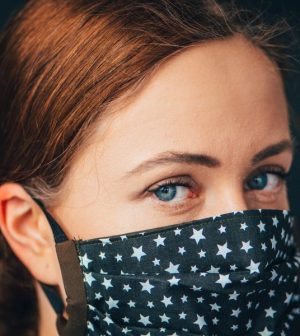- Navigating Your Midlife Crisis: Embracing New Possibilities
- City Raccoons Showing Signs of Domestication
- Mapping the Exposome: Science Broadens Focus to Environmental Disease Triggers
- One Week Less on Social Media Linked to Better Mental Health
- Your Brain Changes in Stages as You Age, Study Finds
- Some Suicide Victims Show No Typical Warning Signs, Study Finds
- ByHeart Formula Faces Lawsuits After Babies Sickened With Botulism
- Switch to Vegan Diet Could Cut Your Greenhouse Gas Emissions in Half
- Regular Bedtime Does Wonders for Blood Pressure
- Dining Alone Could Mean Worse Nutrition for Seniors
Why Cotton Masks Are Safer Masks

Cotton masks provide better protection against the new coronavirus than those made with synthetic fabrics, researchers say.
In a new study, investigators tested different mask fabrics under conditions that mimic the humidity of a person’s breath in order to assess how the fabrics perform in actual use.
Under humid conditions, filtration efficiency (a measure of how well a material captures particles) increased by an average 33% in cotton fabrics, according to the study published March 8 in the journal ACS Applied Nano Materials. That’s because cotton is hydrophilic, meaning it attracts water. By absorbing small amounts of exhaled water in a person’s breath, cotton fibers create a moist environment inside the fabric. That makes them more efficient filters compared to masks made of synthetic fibers.
In general, synthetic fabrics performed poorly in comparison to cotton, and their performance did not improve with humidity. Material used in medical masks was about as effective as cotton, but did not improve with humidity, the researchers said.
A previous study by the same team at the National Institute of Standards and Technology (NIST) and the Smithsonian’s Museum Conservation Institute found that dual-layer masks made of tightly woven cotton fabrics with a raised nap, such as flannel, are particularly effective at filtering breath.
That study was conducted under relatively dry conditions in the lab.
“Cotton fabrics are still a great choice,” said Christopher Zangmeister, a research scientist at NIST, in Gaithersburg, Md. “But this new study shows that cotton fabrics actually perform better in masks than we thought.”
While the researchers found that humidity doesn’t make it harder to breathe through fabric masks, breathing may become difficult if fabric masks get wet in other ways. They should be changed if they get wet due to weather.
The findings offer useful information for people who wear masks, as well as for scientists working to improve masks and measure their performance, the study authors said in an NIST news release.
“To understand how these materials perform in the real world, we need to study them under realistic conditions,” Zangmeister said.
More information
The U.S. Centers for Disease Control and Prevention has more on masks.
SOURCE: National Institute of Standards and Technology, news release, March 9, 2021
Source: HealthDay
Copyright © 2025 HealthDay. All rights reserved.










